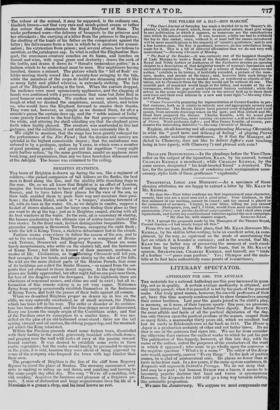BRIGHTON STATISTICS.
THE town of Brighton is drawn up facing the sea, like a regiment of soldiers,—the picked companies- of tall fellows on the flanks, the best men in front along the line, and the shabby little slouching dogs in the rear. Or, as we all know that Brighton is an offset of London, imagine the town-houses to have set off racing down to the shore of Sussex, and to have taken their places for the view of the sea, as their bulk enabled them to push their way and maintain their posi- tions; the Albion Hotel, which is "a tumper," standing foremost of all, with its toes in the water. Or, as we delight in similes, suppose a basket of stones shaken, and the large ones finding their place as they are wont to do at the top : just so is Brighton ranged, staring with all its best windows at the water. In the rear, all is secondary :Ur shabby, the houses graduating to the ultimate size of sentry-boxes shelved into two stories. In the front rank, fashion distinguishes inequalities. The grenadier company is Brunswick Terrace, occupying the right flank ; while the left is Kemp Town, a skeleton detachment lost in the clouds. Fashion seems everywhere to follow the course of the sun, and to set to the westward. Thus Brighton proper is composed of Bruns- wick Terrace, Brunswick and Regency Squares. There are some, hardy mountaineers, who settle on the eastern hill, and the fastnesses of Kemp Town ; but little is known of their manners, customs, or modes of life. Civilization, as thyelorning Chronicle will tell you, first occupies the low lands, and creeps slowly up the sides of the hills. So wild are the more distant parts of the Marine Parade, that some of its buildings are called the Snake Houses,— so named from the ser- pents that yet abound in those desert regions. In the day-time these places are boldly approached, • but after night-fall no one goes near them, for fear of the dragons and the dowagers. In the highlands there are chieftians of renowned names, and clans are said to exist ; but all in- formation of this remote colony is as yet very vague. Noblemen flying from society occasionally establish themselves in the fastnesses of Kemp Town, and hold the passes of their halls against all corners. When we described Brighton proper as drawn up in line on the cliffs, we very naturally overlooked, as of small account, the Palace, which has been left in the rear. The order or disorder of its architec- ture has been often discussed, and the true design never yet discovered. Every one knows the simple origin of the Corinthian order, and that of the Pavilion 'owes its conception to a similar fancy. It was mo- delled on the plan of an old-fashioned cruet-stand : there are the tall spiting vinegar and oil castors, the oblong pepper-top, and the mustard- put which the King inhabited. Within the Pavilion grounds stand some forlorn trees, dissatisfied with their footing in the world, grievously troubled with chalk-stones, and peeping over the wall with looks of envy at the passing inward- bound coaches. It was desired to establish some rooks in these exotic vegetables ; but the rooks would hardly be persuaded to sojourn in the place, it is said, because they were afraid of being pigeoned by some of the company who frequent the town with legs blacker than their own.
The promenade of Brighton is the line of the cliff from Regency Square to libout the place of Snakes. The morning amusement con- sists in wiiIing or riding up and down, and smirking and bowing to the same yeople day after day. The song "We're all a-nodding, nid, nid, nodding," describes the business and pleasure of a Brighton pa- rade. A man of distinction and large acquaintance lives the life of a Mandarin in a grocer's shop, and his head knows no rest.


















 Previous page
Previous page